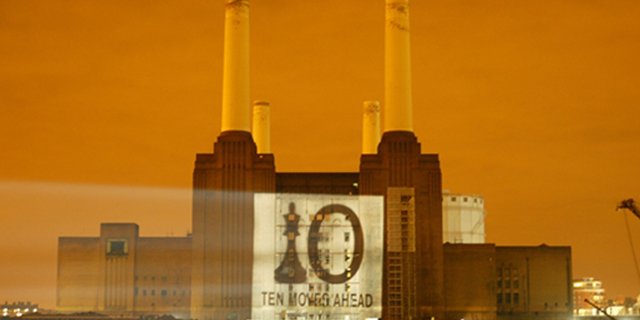
Building Projections: Big Doesn't Always Cut It
For nearly 19 years I’ve activated brands using Guerrilla Marketing techniques, infiltrating brand messages into the space around us, using the landscape as a blank canvas to capture attention and get people talking. I’ve designed and executed outdoor projections for global brands throughout the UK and further afield including the worlds first synchronised projection campaign across 11 countries for Levis 501. You name it - Westminster, Battersea Power Station, White Cliffs of Dover, Angel of the North and Edinburgh Castle – been there, done it to death...and here’s where the problem lies.
Whilst projection technology has significantly improved over the years, the quality and number of suitable canvas sites for so called “giant scale” projections have decreased, their effectiveness diminished somewhat.
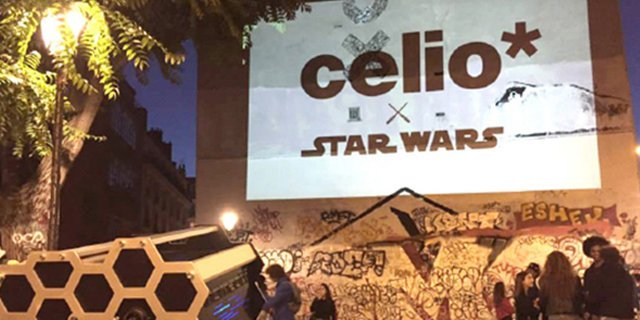
The Power of Imagery
Back in 98, when Kommando first beamed images onto low hanging cloud cover for a new alien blockbuster movie, the press jumped all over it. For a relatively small budget Kommando smashed all client expectations and earned millions of pounds in media exposure. Using a combination of powerful searchlights and projections, this activity was recognised as unique PR stunt that reached BBC Radio, Breakfast news, every red top newspaper and national TV channel. The power of PR news generation at the time was very much image led and focused on appealing to the pictures & news editors, in what we now term as ‘traditional media’. This might be hard for the millennials amongst us to imagine, but we never had the power of social media or mobile phones at our fingertips to spread the word and share experiences quickly.
Looking at projections today, we have access to a wide range of powerful technology and exciting creative applications such as 3D mapping, and with the added amplification power of social media, the reach of a great projection could go global. Think back to the Queens Jubilee, you will probably remember the incredible light show with the crumbling, dancing Buckingham palace or DJ Deadmaus working a crowd at Millbank Tower, London for the launch of the Nokia Lumia 800. In both cases giant scale projections beamed spectacular 3D mapped content in exact synergy with the buildings architecture, accompanied by live music.
These events were highly planned with event scale resources to implement and manage the show. Each show utilised stacked top of the range video projectors, each projector needing 2 - 3 men to carry not to mention the independent power generators to drive these hungry pieces of equipment. What’s incredible is the cost of each projector varies from £30,000 – £100,000. Let’s say for a good quality 3D mapping show like Buckingham Palace, you could easily use 30-50 of these projectors, add logistics, building management, security and an event team before considering the cost of content creation and supporting band or DJ. While it’s plain to see that projection technology and associated complexities like 3D mapping have moved on at the speed of light, there’s huge cost and planning implication in making these shows, making it much less likely to witness a ‘pop up’ or guerrilla style 3D projection show on any old landmark or building.
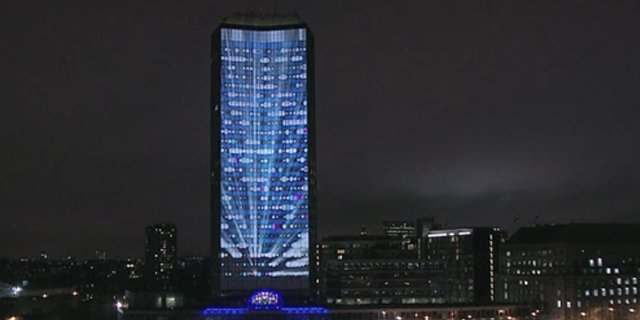
Large-scale Projections
Let’s look at the traditional large scale projection, such as the infamous Gail Porter image which beamed across the Thames onto the Houses of Parliament in 1998 for FHM magazine. Take one of these projectors I’ve mentioned above and look at how we would use it for a 2D static or motion image projection on a building. Typically we require a van, generator and a 2 man team to mobilise and set up the equipment, the same method as it was years ago. The biggest problem and barrier nowadays is this;
Whilst the technology itself may be more powerful, the number of suitable projection buildings and landmark sites are in decline for various reasons (being illuminated, covered in giant posters etc.) and after years of repeated use by brands, they have simply lost their ‘WOW’ factor and attention grabbing appeal. However, the biggest issue today is not a lack of suitable buildings or landmarks - but the increased difficulty in positioning the vehicle and projector to obtain a clear line of sight towards the surface area. Battersea Power Station in London was always a popular target, easy to park at the other side of the Thames and a lovely big flat unlit surface to beam onto, things are not so straightforward nowadays.
When we are approached with a brief for a giant scale projection, the first thing we ask is: “What are you expecting to gain from the projection?” If it’s PR to make the news or get people talking, the answer is [if your absolutely honest] going to disappoint. Firstly, large scale projections onto the same buildings or landmarks that have been targeted for nearly 20 years are hardly going to make the news. The only exception to this would be something like the recent “Vote Leave campaign” where the message and locations selected to beam the message, cemented the core narrative…beaming “Take our borders back” onto the White Cliffs of Dover had a perfect fit within the visual itself….The perfect stunt you could say and this made it easier for the press like the BBC and Sky to engage with the projection stunt.
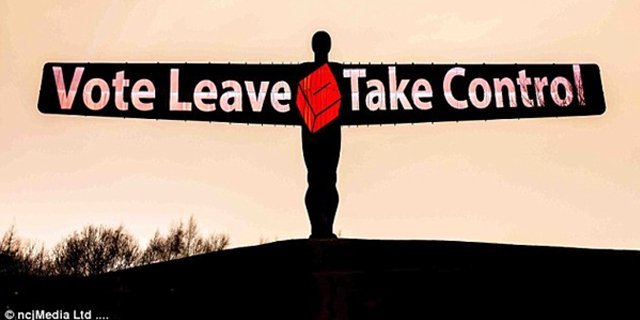
Positioning Problems
I’ve mentioned before that the positioning and parking of vans and support vehicles to get the best beam position (ideally straight on) to the targeted surface is a growing problem. Try amplifying this problem x100 with the current UK terror threat. Ten years ago, if someone asked us to beam onto the Houses of Parliament just off Westminster Bridge, we would have said “Sure, no problem”. Now, if you park a van anywhere near an iconic London building and slide a side door open before switching on a large black electronic box, you’ll be lit up by red dots and promptly slammed to the floor with your arms in cable ties. This stands for most cities and key landmarks under the current UK security threat level and don’t let anyone tell you otherwise…I guess it’s one way to get some press exposure (every cloud and all that) but I’m not sure how the client would respond to a news article with the projection team lying face down in the ground surrounded by SO19, as positive PR.
My point here is simple: large scale projections have a place, albeit a declining role in effective guerrilla marketing, ambient media and PR. Yes, they can provide a nice warm fuzzy feel factor for the client when they see their brand or message on the side of a well-known building, however they are less likely to spot any exposure in the media or even talked about online, which is surely the whole point of marketing. What you will find today is that most of the landmarks are too illuminated to beam onto, the areas that are in the dark are so far away from any relevant traffic or footfall, that what you will end up with is a nice picture for the client with little or no relevant marketing purpose or results. Some might claim that these pictures could be used for posting on the likes of Twitter, Facebook or Instagram to followers and yes this can happen if you ensure you have the right photographer and settings (be wary of the Photoshop altered image) but let’s face it, we’ve all seen these locations used a million times by multiple brands, so you’re hardly going to work your fans into a frenzied excitement or receive any credible word of mouth are you?
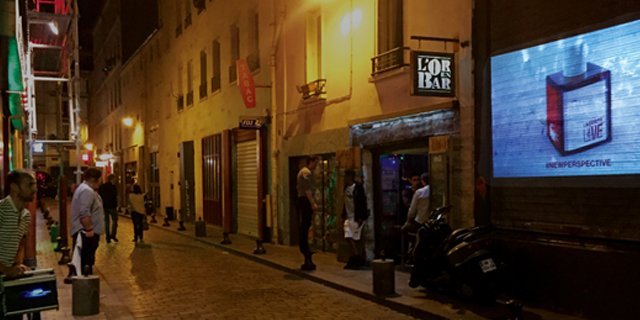
Measuring effectiveness
The effectiveness of a projection is no longer measured as it was all these years ago, no one consumes traditional media as it was before. People share moments immediately with friends & family and having this sharing capability powers the reach of any captured content. In other words, if a projection is placed in front of your target audience in an unusual way, there’s a greater chance of them engaging with the content with their mobile and sharing across social media. You can only achieve this by using highly mobile technology like iProjector.
One thing we love about this technology is that it delivers a genuine experiential experience with its integrated sound system. We know that visual stimuli on its own can be very difficult in creating an experiential engagement, you need at least one other sense like sound or taste to harness emotional context.
Large scale projections used for standard outdoor projections are visual only… unless you add speakers and technical controls - iProjector has this all inbuilt.
While people become more tech-savvy, time-precious and increasingly sensitive to brand intrusion, we as experts in non-traditional media should always recommend the most appropriate use of projection technology that delivers the greatest impact and returns for the client.
If you would like to use the power of roaming projects for your next campaign, contact us today.









